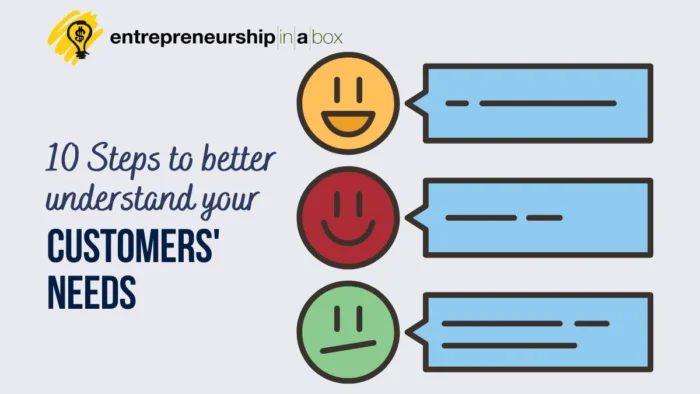Each entrepreneur wants his business to be alone in the market without competition. But, it is an unrealistic and probably unachievable situation, at least for a more extended period, to operate without competitors.
You cannot avoid competition, regardless of the size of the business or industry and the market in which it operates. Even if there is no competition currently, it doesn’t mean it will last forever and will not appear shortly.
You should not be afraid of competition. But, you must implement a strategic and systematic approach to analyzing your competition. After analysis, you will need to use that knowledge in your daily business operations and management of your own business.
If you ignore your competition, you will have real problems manifested through declining market share, lower total sales volume, a decline in the number of customers, and the most significant problems as cash-flow problems. These problems will destroy your business. The fact is that you can not allow yourself to ignore such possible problems.
Because of that, here are the important questions to ask about competitors. Using these questions, you can easily conduct a comprehensive competitive analysis that can be part of your market research and make informed decisions for your small business.
Why do You Need to Conduct a Competitive Analysis?
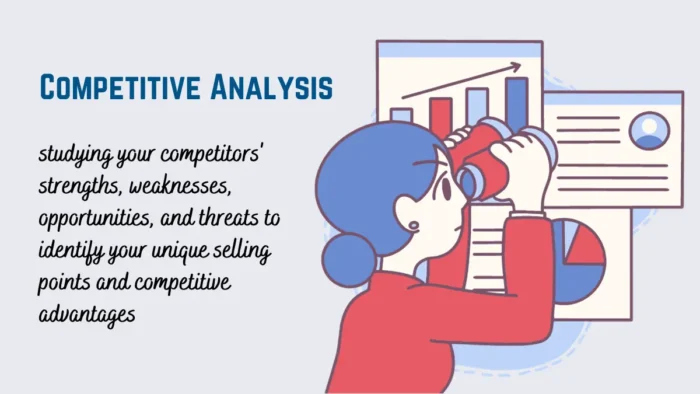
Competitive analysis is essential to your strategic planning process. It involves studying your competitors’ strengths, weaknesses, opportunities, and threats to identify your unique selling points and competitive advantages.
It is necessary to analyze your competitors if you want to stay relevant, innovative, and successful. You will understand the market better, identify gaps in the market, benchmark your performance against competitors, and develop effective strategies to achieve your business goals.
Related: 10 Reasons Being An Entrepreneur Is Better Than Employment
Answering questions that we will cover in the rest of this article can provide you with valuable insights into:
- Market trends: What’s new in the industry? What are customers currently interested in?
- Competitor strategies: What strategies are competitors using to attract and retain customers? How effective are these strategies?
- Customer preferences: What do customers like or dislike about your competitor’s products or services?
- Stay on top of the industry trends: By understanding what your competitors are doing, you can identify opportunities for growth and potential threats to your business.
- Improve product/service offering: Analyzing competitors’ products or services can help you improve your offering to meet customer needs better.
- Better marketing strategy: Understanding where are your competitors focusing their marketing efforts and how they reach their customers can help inform your marketing strategies.
The important thing is to use the insights you will gain from your analysis to improve your products or services, adjust your pricing, or change your marketing strategies.
Now, let’s go deeper with competitor analysis questions.
Know Your Competitors
1. Who are your main competitors that can significantly influence your business?
The first thing you need to do when conducting competitive analysis as a part of your market research is to define your main competitors. Remember that you must define them based on their influence or the influence they will have in the future on your company.
List 5 to 10 most important companies you have identified as competitors.
2. Where are they compared to you when you conduct a competitive analysis?
When you already have a list of possible significant competitors, you can analyze them to answer this question. You can use competitor analysis, and the result from this analysis will be a simple comparison between your business and your competitors based on the most critical elements of doing business.
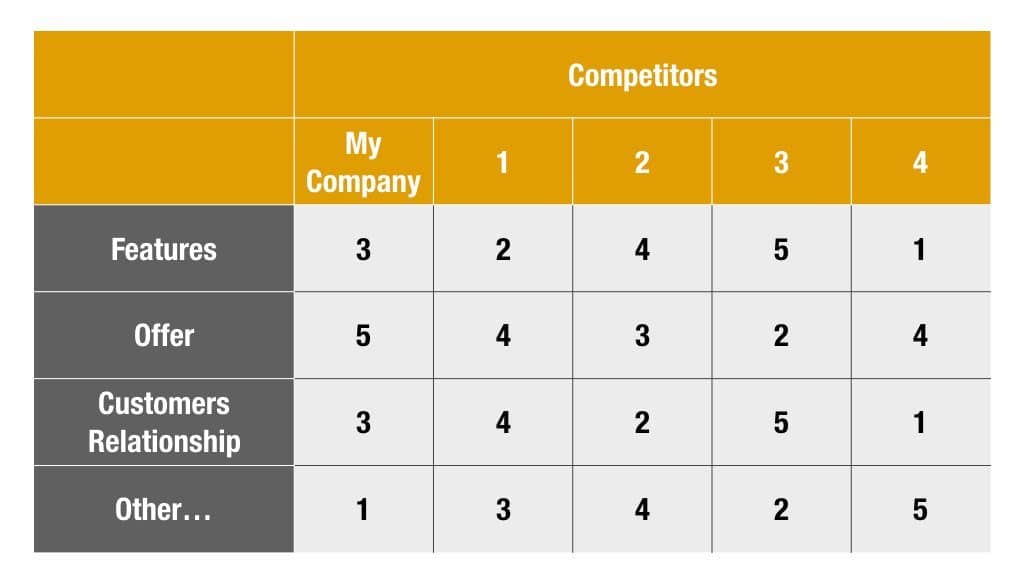
Conducting competitor analysis is important if you want to compare yourself with your competitors. Focus your competitor analysis on the following:
- What is their market share?
- What are the biggest competitor’s strengths compared with your company’s strengths?
- What are competitors’ pricing strategies?
- Where and how they are promoting their products or services? What are their marketing efforts?
- How do they handle customer complaints, inquiries, and feedback?
- What is the unique selling proposition that differentiates them from the rest?
3. What potential competitors are not yet competitors but can be in the future?

Inside your competitive analysis, you must think about the future competitors or possible companies that still aren’t your competitors but can become in the future. Consider possible substitute products or innovations that can come in the future and will compete with your current offer.
This requires a keen understanding of the industry and market trends, as well as an awareness of any emerging technologies or potential substitute products that could disrupt your current offerings.
To effectively analyze future competitors, start by researching companies that are similar to your market. Look for similarities in their products and services and assess their potential to compete with your offerings.
Also, monitor emerging technologies and assess their potential impact on your business. This could include things like new software or hardware that could disrupt your current business model or new applications of existing technologies that could lead to substitute products.
Related: Real-life Organizational Decision-Making Examples
Competitor’s Products and Services
4. What are your competitor’s products or services?
When you define your competitors, think about the products and services they offer on the market to your ideal customers. So, make a list of all products and services that your competitors currently offer to the customers and future products and services they are developing and plan to offer.
By doing so, you will be able to understand the competitive landscape in your industry better, enabling you to identify potential areas for improvement or differentiation in your own products or services.
Additionally, this information can help you identify any gaps in the market that your business could fill, giving you a competitive advantage over your rivals.
To create an effective list of your competitors’ products and services, you should consider various factors, including the quality, price, features, and benefits of each offering. You should also consider the target market that each product or service is designed for, as well as any unique selling points that your competitors may have.
A comprehensive understanding of your competitor’s products and services is crucial for developing effective business strategies and staying ahead in a competitive marketplace.
5. Where are their products or services compared to yours?
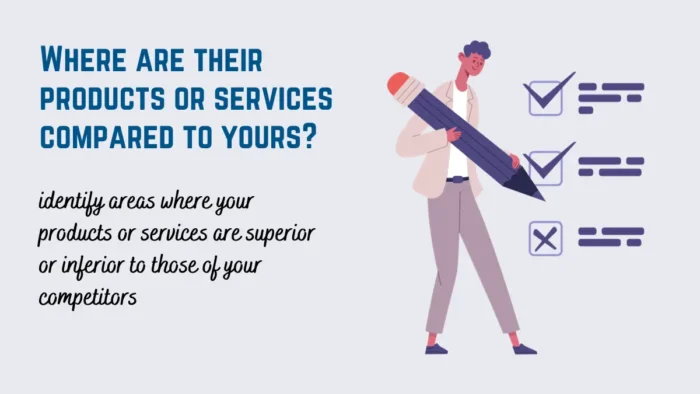
You will do a similar analysis as presented in the competitive analysis matrix because you have a list of competitors’ products and services answering this question.
To determine the position of your products or services in the market, you can conduct a comprehensive analysis by comparing them with the products or services offered by your competitors. This analysis will involve creating a list of all your competitors’ products or services and examining how they compare to yours.
By doing so, you will be able to identify areas where your products or services are superior or inferior to those of your competitors. This information will be useful in making strategic decisions on improving your offerings and gaining a competitive edge in the market.
6. What is the value that your competitors offer to their customers?
Think about the value that your competitors are offering to their customers. This can be product characteristics, features, price points, quality, benefits, problems, etc.
We’re talking about the value that your own company and your competitors offer to its customers, which means comparing your offerings to what competitors are offering, where the gap is, and how you’re going to fill it.
Also, you must think about the perceived value. The perceived value of their products can largely be influenced by the quality of materials they are using, production processes, marketing strategies, or pricing points.
These are essential things you need to follow and analyze for your competitors.
7. Are they delivering more or less value to their customers than your offer and your deliverables?
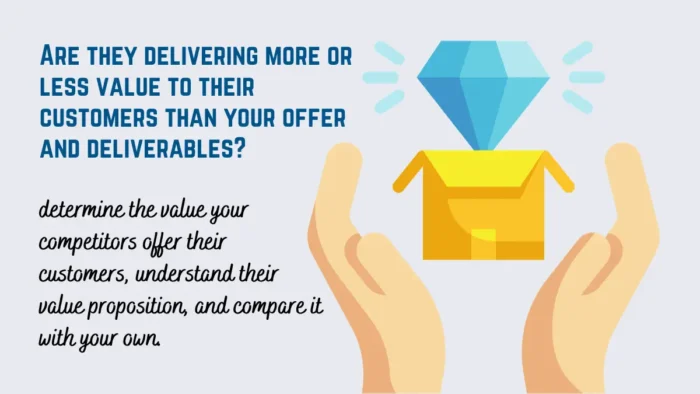
When you define their value, you can compare it with the value you offer to your customers.
It’s crucial to evaluate whether your business provides more or less value to customers than your competitors. This evaluation can help you identify areas where you can improve your offerings and stay competitive. To initiate this evaluation process, you must first determine the value your competitors offer their customers. Once you clearly understand their value proposition, you can compare it with your own.
Use a benchmarking tool to identify gaps and visualize the key differences between you and your competitors.
This will help you identify the areas where you need to focus on improving your products.
8. What benefits and features do their products or services offer?
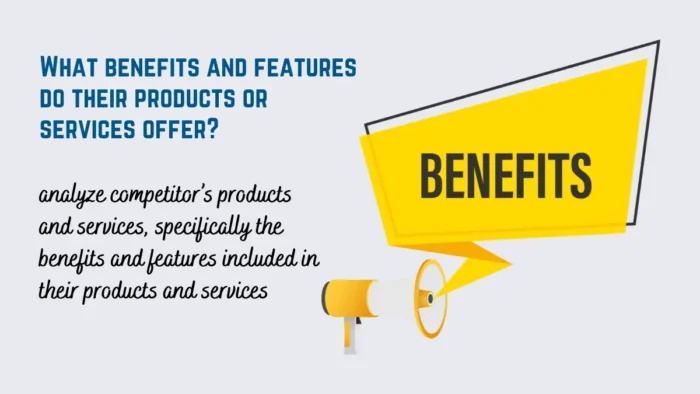
You can also analyze their products and services, specifically the benefits and features included in their products and services.
What are the advantages of using a particular product or service? A company can always say that its product or service is excellent, but its benefits and features must be clearly defined to be persuasive.
Competitor’s Offer
9. What is something good about their offer that you don’t have in your offer?
When conducting competitive analysis, it is essential to analyze and compare your competitor’s total offer with your offerings.
The goal of this question is to identify and write down everything you can find that is unique to their offer and that you can think about implementing and persuading your customers to give you a chance.
10. Can you implement something that you don’t have currently in your value that your competitors have?
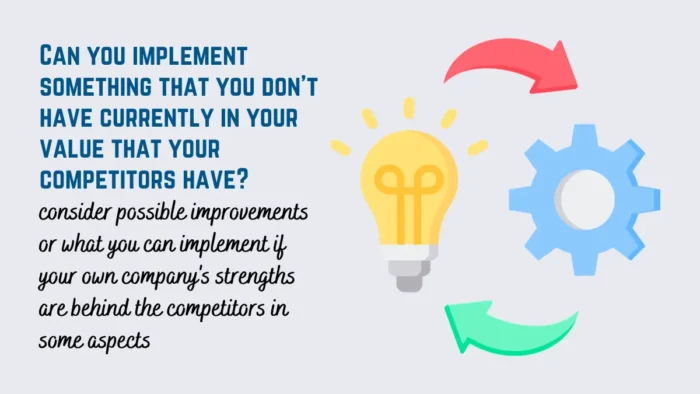
You already know the difference between your and your competitor’s value with previous questions. So, now you need to consider possible improvements or what you can implement if your own company’s strengths are behind the competitors in some aspects.
Consider what steps you can take if your company’s strengths are lacking in certain aspects compared to your competitors. This could involve adopting new technologies, optimizing your internal processes, or investing in employee training programs.
By identifying these areas and taking proactive steps to address them, you can level the playing field and enhance your company’s overall value proposition.
11. What is their total offer?
As you already know, the products and services are part of your offer, but only the part, not the total offer. Your total offer must include more things that will be your unique value proposition. Read more about the four questions about your total offer from the customer’s perspective.
12. Is it different from your offer?
If it differs from your total offer, what are the differences? Do they know something more about the customers on the market?
These are essential questions as a part of your competitor analysis to learn more about them and the customers that you are also targeting.
13. What are the elements where their offer is better than yours?

Answering this question, you will create a list of the elements of your competitor’s total offer that you don’t offer to your customers.
So, in such a way, if there is a gap, you will fulfill it with a better offering. Also, you can improve your offer to differentiate yourself and be one step ahead of them.
14. What are the elements where your offer is better than theirs?
Probably, you will have something in which you are better than your direct competitors when it comes to the offer. So, think about it and relate them to your customers. Are your customers satisfied, and do they value these differences?
Customers
15. How are they developing and finding their customers?
What are they doing to develop and find new customers? Answering this question, you will look deeper inside their innovation process, the value they are producing, and how they develop customers for their own brand and innovative products.
Also, in this competitive analysis, you will compare their marketing efforts with yours. This question is essential to examine the marketing efforts and differences between you and your competitors. Respond to where your competitors focus their marketing efforts to find new and retain existing customers.
16. Who are their most important customers?
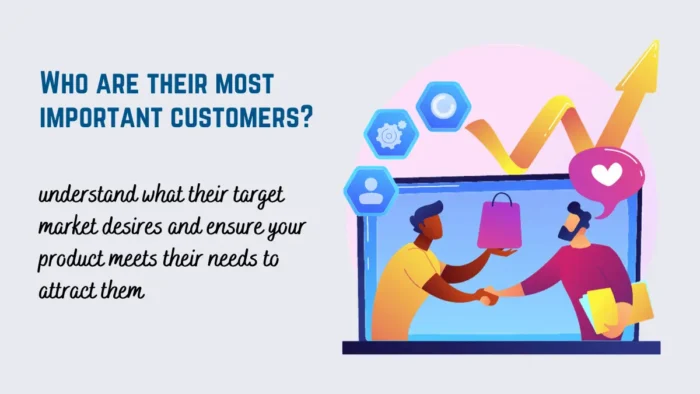
Think about the segmentation and what they are targeting.
You can use social media platforms and search engines to determine who purchases their products or services. Although it might not always be the same group of people, it is highly likely that the ones you want to attract are consumers currently buying from your competitors.
Therefore, it is crucial with your competitor analysis to understand what their target market desires and ensure your product meets their needs to attract them.
17. How do your competitors encourage their customers to buy from them?
Knowing their sales process and what techniques and approaches your competitors use to encourage their customers to buy from them is essential for competitive analysis.
Closely look at their sales process, sales tactics, call to action, promises, and language to approach and encourage customers to buy from them.
18. How much do they charge for their products or services?
Now, it is time to ask and answer the question related to the pricing. Answers to previous questions give you many attributes that can help you check where you are positioned regarding your pricing strategy.
19. Where are they advertising their products or services?
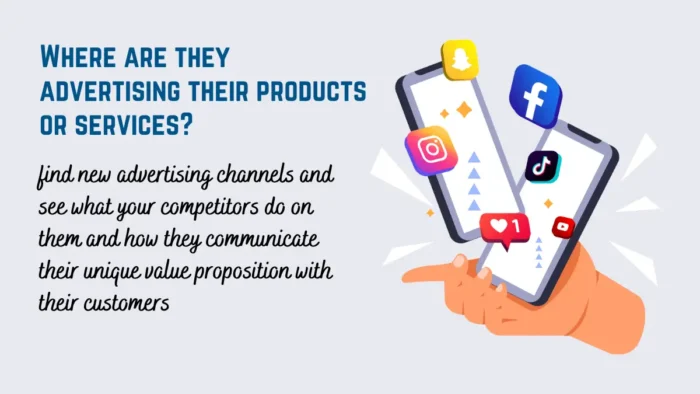
Knowing and following your competitors’ advertising strategies and tactics is essential when conducting competitor analysis. Answering this question, you will find new advertising channels and see what your competitors do on them and how they communicate their unique value proposition with their customers.
Managing Competitive Landscape
20. How are they recruiting new staff with high skills for their business?
This is an essential question about their human resource approach in your competitive analysis.
A competitive advantage often takes the form of a strong workforce, including a strong sales team, that you can recruit and hire the best talent.
Related: The Team Effectiveness and Different Roles in Teams That Win
21. How often do you conduct competitive analysis?
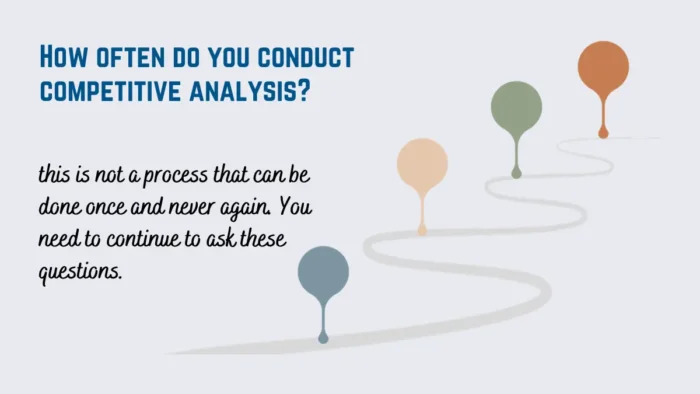
This is not a process that can be done once and never again. You need to continue to ask these questions.
Your competition is never going to let you forget about them. Even if you’re not competing directly with them, their tactics influence how you do business.
If you want to outsmart your competition, see how they use the tools at their disposal to beat you. This is how you can learn from their mistakes, strengths, and weaknesses to stay ahead of them.
22. Do you apply the findings of the competitive analysis in your everyday operations?
As the last question, you want to check what you have done when you answer all these questions.
Why do you need to lose your time if you don’t take action to improve your business and become better than your competitors?
Conclusion
Asking the right competitive analysis questions is crucial to beating your competitors and achieving success. These 22 questions provide a comprehensive framework for conducting analysis. By answering them, you can gain valuable insights into your competition, identify growth opportunities, and develop strategies that cater to customer preferences and market trends.




